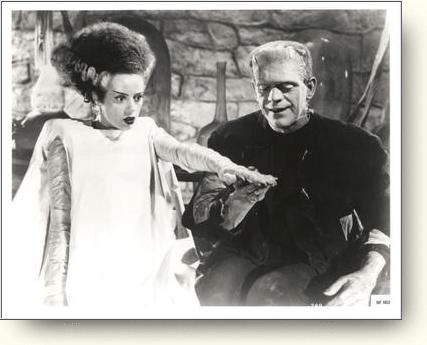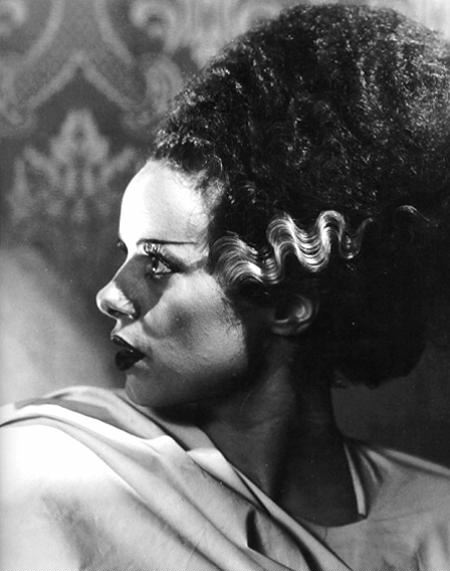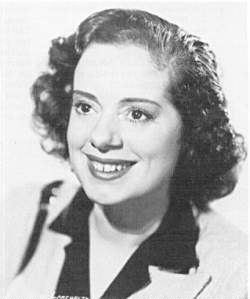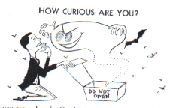The Bride of Frankenstein Sings Bawdy Cockney Songs!
Elsa Lanchester Gets Lost in Music Hall
by Jeff Bagato

The curtain rises, revealing a grand piano stage center. Lanchester comes out wearing a long rolex perpetual cream taffeta gown decorated with lace that was "worked with small mauve ribbon baskets filled with midget pink roses." Her visage, too, is unique, fake breitling watches with slightly popped eyes, snub nose, cleft chin and dramatic mane of curly auburn hair. Elsa has no books. Instead of reading, she begins to sing in a voice Time magazine once called a "scrape-fiddle soprano":
"When a lady has a piazza, she has a prize indeed...
She can look on her piazza as a friend in need.
For a girl who has a piazza has a place on which to sit,
And people know a piazza has a house attached to it."
Elsa's costume for "When a Lady Has a Piazza" |
"It seemed always fun for the audiences to get my show in place of Charles'," Lanchester wrote later in her 1983 autobiography, Elsa Lanchester--Herself (St. Martin's Press). "Instead of what they expected--serious readings of the Bible and Shakespeare--they got a clown. The unexpected. A surprise--discovering a clown when you expected Thomas Wolfe or Jack Keroac."
Today, you know Elsa Lanchester as a movie star even if you don't recognize her name. In 1964, she played "Katie Nana," the nanny who quits work and is replaced by Mary Poppins. But thirty years before that, Lanchester became the poster girl for one of the greatest horror movies of all time, James Whale's "Bride of Frankenstein," playing a double role of Mary Shelley and the Bride. Until her death in 1986, Lanchester happily signed photos of herself from the film, with her hair combed up in a Nefertiti beehive with a distinctive shock of white hair running up each side. Over her long career, she appeared in over 60 films and numerous theatrical productions; most of her film roles were minor parts in long forgotten pictures like "Northwest Outpost" (1947), "The Girls of Pleasure Island" (1953); "Pajama Party" (1964) or "Terror in the Wax Museum" (1973); or she appeared as second fiddle to her better known husband in "Rembrandt" (1936)--which features a song she wrote and sang--or "The Beachcomber" (1938).
But among her stage work, Lanchester performed a long running nightclub
act at the Turnabout Theatre in Hollywood, in which she performed gently
naughty songs filled with double entendre and sexual innuendo: pieces like
"Linda and Her Londonderry Air," "If You Peek in My Gazebo," or "When a
Lady has a Piazza."
Bawdy Cockney Songs |
Songs for a Shuttered Parlor |
In 1957 and 1958, Lanchester recorded these tunes on two LPs for the HiFi Record label that you can find in thrift stores today: first "Songs for a Smoke Filled Room," then "Songs for a Shuttered Parlor." Both LPs featured song introductions by Laughton. In 1961, the albums were reissued as "Bawdy Cockney Songs" and "More Bawdy Cockney Songs," respectively, with Laughton's commentary omitted. A CD reissue of the 1961 versions is circulating today as "Elsa Lanchester Sings Bawdy Cockney Songs" with "Bride of Frankenstein" also prominently flagged on the cover. While her autobiography details her stage renditions of these songs, it neglects any mention of the recordings; it's clear Lanchester considered herself an actress and not a recording artist, let alone a singer: "I am, or was, a diseuse who tells a story rather than sings it."
Lanchester first gathered her material back in 1924, when she was living in London and working as a dancer at age 22. With her romantic partner Harold Scott, she founded a midnight theater called The Cave of Harmony, which presented one act plays by Pirandello and Checkhov. In a short time, their theater was visited by H. G. Wells, Aldous Huxley, Evelyn Waugh, and James Whale; John Gielgud had his first professional job there. As a kind of filler material, Lanchester writes in her autobiography, she "re-created the Victorian era under the title of 'The Old Mahogany Bar,'" presenting out-of-print songs she researched in the British Museum. Among her earliest finds were "The Rat Catcher's Daughter," "The Boatman's Dance," "Buffalo Gals," and "Please Sell No More Drink to My Father," which was "written as a serious Temperance song." Evelyn Waugh frequented the club especially to hear her rendition of "My Yiddisher Boy (With His Yoy, Yoy, Yoy)." Some Cave of Harmony regulars wrote songs for her, like poet Herbert Farjeon or Philip Godfrey, who gave her "Somebody Broke Lola's Saucepan."
Up until this point, Lanchester had seen herself as a dancer, studying with Isadora Duncan as a teenager and teaching dance in private schools; in her first theatrical job she performed the "Ballet Egyptian"--belly dancing to you and me--as part of vaudevillian Ida Barr's comedy act. Living in London, Lanchester performed at the Cave of Harmony at night and was teaching dance, hanging about in bohemian cafes, or posing nude for artists by day.
It may surprise you to learn that this character actress we often associate with the nosy old ladies of Disney's "That Darn Cat" or "Blackbeard's Ghost" was born to such a colorful life. Lanchester's parents were Socialists well-known for speaking at political rallies and who had defied the conventions of the day by refusing to marry. In fact, Edith Lanchester, Elsa's mother, was kidnapped by her father and brothers, who wanted to make her an "honest woman." On October 28, 1902, Elsa entered a household taken over by radical -isms--vegetarianism, Communism, pacifism, agnosticism--a family environment that shaped her view of life as an adventure.
Lanchester first appeared on film during the Cave of Harmony days when Evelyn Waugh and his cronies made a rambling underground farce they called "The Scarlet Woman." It was a fitting vehicle for a free spirit who's stage persona was described thus by poet Herbert Farjeon in Vogue: "Her hair is in the chestnut trees of London and her feet are in the mud of the Thames." During this period Lanchester made two 78 RPM recordings for Columbia Records of her Cave of Harmony material: first came "Please Sell No More Drink to my Father" cut with "He Didn't Oughter (Riverside Nights)," released 8/26/26, then "Don't Tell my Mother I'm Living in Sin" with "The Ladies Bar," released 2/14/1930.
By the time of her second recording, Lanchester was established as an actress on stage--she appeared in the review "Riverside Nights" with Frankenstein director James Whale serving as the stage manager, actor, and scene designer--and in films: by 1927, when she first met Laughton, she was working on a series of three short films written for her by H. G. Wells ("Bluebottles," "The Tonic," and "Daydreams"). She closed the Cave of Harmony in late 1928. In February of the following year, she married Laughton; two years into their marriage, she learned he was homosexual, but they remained married until his death in 1962. In 1932, they arrived in Hollywood, where Laughton appeared in "The Old Dark House," directed by James Whale, and "The Devil and the Deep." They became U.S. citizens in 1950.
While Laughton remained busy with film roles during their first years in Hollywood, Lanchester became discouraged that she wasn't working. She had returned to England to look after their property there when James Whale called her back to America with not one but two parts: she was to play Mary Shelley and the Bride of Frankenstein. For about ten days, Lanchester was so wrapped in yards of bandage and covered in heavy makeup that she "didn't particularly want to be seen by anyone" off the set. In her book, she describes the technique for making her hair stand on end (it was combed over a wire mesh cage), and the agony of keeping her eyes wide open for long takes when the monster first comes to life: "My eyes were actually in pain, which must have only added to the look of horror I was supposed to show." And she notes the secret of the monster's amazing screaming and hissing sounds "to show my anger and terror when rebuffing my groom"--it seems the greatest diss in horror films was based on the sound made by the swans of Regents Park in London; the soundmen ran Lanchester's vocalizations backwards to "add to the strangeness."
In 1941, Lanchester returned to her musical performances at Hollywood's Turnabout Theatre, on La Cienaga Blvd, run by the Yale Puppeteers: Forman Brown, Harry Burnett, and Roddy Brandon. The theater held two stages on either end of a narrow room, a puppet show on one and live performers on the other; in between were reversible seats like on a streetcar or beach boardwalk, where the back could be flipped to face one side or the other. Three weeks after the Turnabout opened, Lanchester made her debut there as a "guest artist" with three of her old songs, in a different costume for each: A. P. Herbert's "He Didn't Oughter (Come to Bed in Boots)," "The Ratcatcher's Daughter," and "Somebody Broke Lola's Saucepan." This performance set the mold for her ten years of appearances there nightly except Mondays, 11 months out of the year: "Pretty songs, funny songs, wicked songs," a character for each, for each character a costume. (You can see pictures of these characters in her book and on the jackets of her original LP issues.)
Of her work at the Turnabout, Lanchester writes:
"My appearances in each of the reviews consisted of three solo spots. As a performer known principally as a film personality, I hoped first of all to avoid the conventional movie image in my characterizations. I wanted to look unlike an actress trying to look more glamorous than she is. Therefore, in my first spot I became a kitchen slavey, a frowzy housewife, or a slum brat. A collection of distinctly unglamorous females. My second spot was usually a ballad. Since I was an actress, I tried to tell a story and create--in dance and song--a picturesque character. As these ballads were usually period pieces, they gave me a chance to move about the stage and dance in colorful costumes. And now, having shown myself looking my worst and best, for my last number I could be anything, however outrageous--a potentate's mistress, a lady of the night, and that sort of thing."
It was arranged that Lanchester would not be paid for her appearances at the Turnabout, but she would get to keep the 50-60 songs Brown wrote for her over the years, starting with "If you Can't Get in the Corners (You Might as Well Give Up)," which Lanchester played as a cleaning lady. They felt it essential to end each song in an upbeat mood, even those numbers--like "Melinda Maime"--in which Forman indulged a romantically sorrowful atmosphere. Forman, Lanchester says, was "a specialist in double entendres. But I sometimes topped him, for he would often say at an early rehearsal, 'How could you think I meant that?!'"
During the day, she made films, at night she sang. Upon her 2000th appearance, Turnabout threw a party for her that was attended by a Time reporter, who called her "the burlesqueen of what is probably the world's toniest vaudeville palace." He also noted the effervescent energy of her performances despite being "delivered in a scrape-fiddle soprano, with a prodigality of gesture and squirrel teeth."
Toward the end of her run at the Turnabout, Lanchester began preparing a nightclub show with pianist Ray Henderson; they even took this show to London's Cafe de Paris, but in the wake of her recent declaration of American citizenship, the press criticized her for going Yankee and dropping the "charming little English ditties I used to sing years ago" in favor of Brown's material.
Returning from England, Lanchester played the Turnabout and a supper club called The Bar of Music simultaneously, rushing from the Bar's dinner show to the Turnabout and back to the Bar for a supper show--23 songs total each night. Witnessing her success, promoter Paul Gregory (who managed Laughton's reading tours) created a touring concert show for her called "Elsa Lanchester's Private Music Hall." To reinforce her singing, Gregory added a male vocal quartet known as The Mad Hatters to the bill, with Henderson as pianist, music director, and arranger. The show opened in Vancouver and rolled on to 60 performances at colleges and auditoriums around the U.S. The audiences were "always full and wild," Lanchester recalls, but critics noticed the narrow range of the material Gregory had restricted her to. Time's review of her October 1950 show in New York City quotes her as saying, "Boston was puzzled by anyone who even looks like me," and "I can't sing." This latter admission, the reviewer notes, "did bother a little." The tour ended in late 1952, and Henderson went into the army a few months later in 1953; Lanchester returned to The Bar of Music with another accompanist. Gregory abruptly canceled a second tour with Henderson for reasons unknown to Lanchester, but she learned that some sponsors were told her performances were "too risqué" for colleges--"which were always the greatest audiences we ever had."
Eventually, Laughton decided to create and direct a one-woman show for Lanchester, piecing it together from her Turnabout material and dictating a stage set with two pianists: Henderson doubling as musical director, and Don Dollarhide. Among the songs they performed were "Won't You Buy My Sweet Blooming Lavender," "Our Threepenny Hop," "The Ballad of Sister Anne," and "When a Lady Has a Piazza," with additional material by Sir Osbert Sitwell, Thomas Wolfe, Euripides, and Henry VIII. Late in 1960, the show had a tryout in Stockton, California. As Lanchester tells the story, Laughton originally had refused to have his name on the program, but when he saw the audience's enthusiasm at the tryout, he "leapt from his seat and ran to the back of the auditorium and pounded on the locked door, trying to get in backstage. Finally someone let him in and Charles rushed through the stage curtains to take a bow, too--but by this time the audience had all left." Laughton grudgingly allowed "Censored by Charles Laughton" to appear in subsequent programs.
Laughton continued to give his wife problems through the run of her show. On opening night at UCLA, he "tried to throw himself down the concrete front steps," demanding pills so he could kill himself. Lanchester recalls she rushed to the scene and slapped Laughton to bring him out of his hysterical state. She says she later told him he was trying to destroy her and her show: "How can I possibly stand on that stage now and be light and cheerful as if nothing happened!" Laughton apologized and was taken away by a doctor, while Lanchester called a physician friend in search of a sedative to calm her nerves. His remedy: drink a glass of water. "I did, and gave a very good performance," Lanchester notes, "one almost elevated by the horrifying experience." The next night in Santa Barbara, Lanchester writes that the reaction to Laughton's breakdown hit: she forgot all the words and had to be coached through the show by her sidemen.
Later, when Laughton had to cancel his own reading tour dates in the midwest due to his battle with the bone cancer that killed him on December 15, 1962, his manager booked "Elsa Lanchester--Herself" instead, but with only one pianist. Elsa recalls that Laughton was furious that she and Henderson would change the show from a threesome, ranting and actually "forbidding" her to perform a show that did not meet his original specifications. They were forced to re-form the show and do the performances without his blessing.
Read a shorter version of this article in Cool and Strange Music magazine #28! |
Discography:
"Please Sell No More Drink to my Father" & "He Didn't Oughter (Riverside Nights)" (8/26/26 78-RPM; Columbia 4125)"Don't Tell my Mother I'm Living in Sin" & "The Ladies Bar" (2/14/1930 78-RPM; Columbia DB 81)
"All Talking! All Singing! All Dancing!- Great Movie Stars of the '30's" (1930 LP; Parlophone PMC7141)
"Songs for a Smoke Filled Room" (1957 LP; Vogue VA 160126/Hi-Fi Records 405)
"Songs for a Shuttered Parlor" (1958 LP; Vogue VA 160139/Hi-Fi Records 406)
"Bawdy Cockney Songs" (1961 LP; Tradition label) [Reissue of "Songs for a Smoke Filled Room."]
"More Bawdy Cockney Songs" (1961 LP; Tradition label) [Reissue of "Songs
for a Shuttered Parlor"]
Selected Filmography:
Die Laughing (1980)Murder by Death (1976)
Arnold (1973)
Terror in the Wax Museum (1973)
Willard (1971)
My Dog the Thief (1969)
Rascal (1969)
Blackbeard's Ghost (1968)
Easy Come, Easy Go (1967)
Meu Tesouro É Você (1967)
That Darn Cat (1965)
Mary Poppins (1964)
Pajama Party (1964)
Bell, Book and Candle (1958)
Witness for the Prosecution (1957)
The Glass Slipper (1955)
Stranger in the Night (1955)
Hell's Half Acre (1954)
The Girls of Pleasure Island (1953)
Androcles and The Lion (1952)
The Petty Girl (1950)
The Inspector General (1949)
The Secret Garden (1949)
Come to the Stable (1949)
The Big Clock (1948)
The Bishop's Wife (1947)
Northwest Outpost (1947)
The Spiral Staircase (1946)
Passport to Adventure (1944)
Forever and A Day (1943)
Lassie Come Home (1943)
Beachcomber (1938)
The Ghost Goes West (1936)
Rembrandt (1936)
The Bride of Frankenstein (1935)
Naughty Marietta (1935)
The Private Life of Henry VIII (1933)
The Scarlet Woman (1926)
Nonetheless, Lanchester praises Laughton's work on the show, noting that it "had a good, solid continuity to it, like a successful conversation....After almost every single show, people came round and embraced me as if I were an old friend..." She marvels at a February 4, 1961 performance in New York City for which the Forty-first Street Theatre was full despite a snowstorm outside. In its review, Time magazine crowed: "If there's anyone who can make you forget about 17.4 inches of snow, it's Elsa Lanchester...even if you have to use dog sleds, skis or bulldozers, drop in on Elsa. She won't let you down." She was quoted in The Diplomat magazine saying "The audiences don't know what I'm going to do when I first come on. They think of me as Mrs. Charles Laughton and expect me to read the Bible. Instead, they get 'Songs for a Shuttered Parlor.'"
Although Lanchester was often frustrated that her film career was stalled by "large parts in lousy pictures and small parts in big pictures" (like the ones for Disney), she always enjoyed her musical performances. A brief return to the stage in 1964 for two three-week runs of Elsa Lanchester--Herself with Ray Henderson at Hollywood's Ivar Theatre, reminded her that she "was content because I was fully aware that I did not like straight acting but preferred performing direct to an audience. You might call what I do vaudeville. Making a joke, especially impromptu, and getting a big laugh is just plain heaven."
Into the 1980s, Lanchester and Henderson worked on their original musical setting of T. S. Eliot's Old Possum's Book of Practical Cats, in which Lanchester read the poetry over Henderson's orchestral music. She reports having given several private performances of the piece, even though Eliot refused to grant her permission to record the work when he was alive--a prohibition he reiterated in his will. In the wake of Andrew Lloyd Webber's Cats, which was also based on Eliot's work, Lanchester explains that her exclusion from recording privileges must originate in Eliot's jealousy over her friendship with their mutual friend John Heyward.
When she wrote her autobiography in 1983, Lanchester was rehearsing with Ray Henderson; although they weren't preparing for a show, Lanchester notes, "these rehearsals with Ray have become very important. They are therapeutic and wonderful for breathing exercise." Shortly afterward, in 1984, she suffered a stroke and never returned to the stage. She died of bronchiopneumonia on December 26, 1986.
Giving her discs a spin once more, one is struck by the singular quality of Lanchester's singing. To say that it is not the greatest oversimplifies matters. Her voice is high pitched and a bit creaky, threatening to crash on the faster parts, but she uses these faults to her advantage, highlighting the eccentricity of her material and breathing an air of innocence into it's bawdiest corners. Like a Frank Sinatra on helium, she expands a song to its bursting point, filling it with pregnant pauses, gasps, giggles and grins, winking and nudging through the story with maniacal glee. Henderson's piano gooses the stories along in similarly playful style. We can almost believe that this squeaky, funny, red-haired lady with the excellent British diction and crazy interpretative skills might not actually understand the "naughtiness" of her songs; certainly her characters--waitresses, cleaning ladies, daughters of tinkers or ratcatchers, desperate or reluctant spinsters--don't always get it.
One must wonder if even Lanchester's reviewers understood the innuendo. In a 1957 review of "Songs for a Smoke-Filled Room," Time described "If You Peek in My Gazebo" as a "tale of a mad New England spinster who sits each evening in a summerhouse on the hill secretly watching the lusty young village bucks stroll by." On record, Lanchester sings:
"If you peek in my gazebo as you are passing by
you will see a sight that will delight the most fastidious eye....
And as I serenade them there's just one thing that's wrong
there aren't enough peepholes to go around."
Elsa's suggestive laugh let"s you know without a doubt who"s doing the looking...and what the price may be.
There's no mystery why Laughton's song introductions were omitted in later versions--he's strictly an intrusive presence, ponderous and pretentious and neither especially informative or witty, that disrupts the continuity of the kind of magic Lanchester must have brought to the stage. When he laughs, sobs or joins in on the chorus of "She Was Poor But She Was Honest," Laughton sounds like he's in a hole. Accept the reissues gladly, and seek out the first volume ("Songs for a Smoke Filled Room," aka "Bawdy Cockney Songs") for a livelier romp through more colorful material.
For reference, Lanchester sings the following songs on "Songs for a Smoke-Filled Room": "Fiji Fanny;" "At the Drive In;" "If You Can't Get in the Corners;" "Please Sell No More Drink to My Father;" "When a Lady Has a Piazza;" "Linda and Her Londonderry Air;" "If You Peek in My Gazebo;" "Catalog Woman;" "Rat Catcher's Daughter;" "Never Go Walking Without Your Hat Pin;" "The Husband's Clock;" and "Lola's Saucepan." "Songs for a Shuttered Parlor" includes: "I Didn't Know Where to Look;" "The Yashmak Song;" "It May Be Life;" "Faith, Hope and Charity;" "Little Fred;" "I'm Glad to See Your Back;" "My New York Slip;" "The Janitor's Boy;" "The Ruined Maid" (by Thomas Hardy!); "Mrs. Badger-Butts;" "Melinda Maime;" and "She Was Poor But She Was Honest."
Lanchester's performances on record have lighthearted energy, with natural comedic timing, and the whole thing has an authentic feel of an intimate evening in a private social club--one both shuttered and smoke-filled, where all the drinks are top-shelf and the dress is formal and well-tailored. Something like the Turnabout or the roaring 20s boho London scene of Cave of Harmony! You can almost hear the movie stars, the lords and ladies and literary figures--the gliterati of years past--laughing along with Elsa's sparkling charm.
These LPs are time machines, then, and Lanchester is effortlessly delightful
as a hostess. We can't ask anything more of our thrift store finds.
END
[A much shorter version of this article appeared in Cool and Strange Music magazine #28.]







